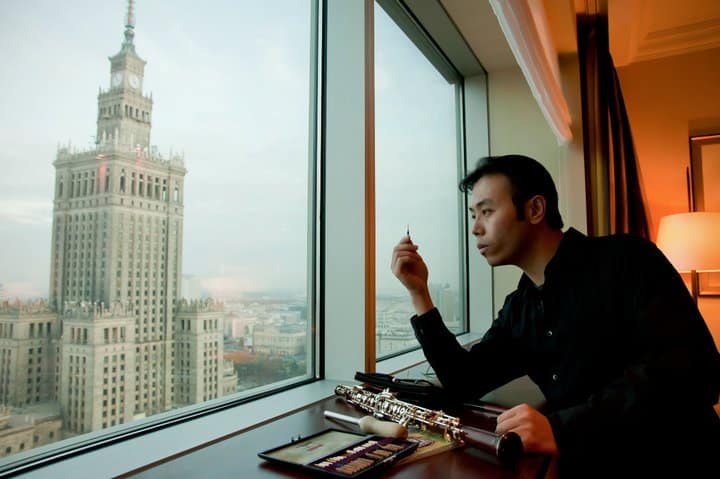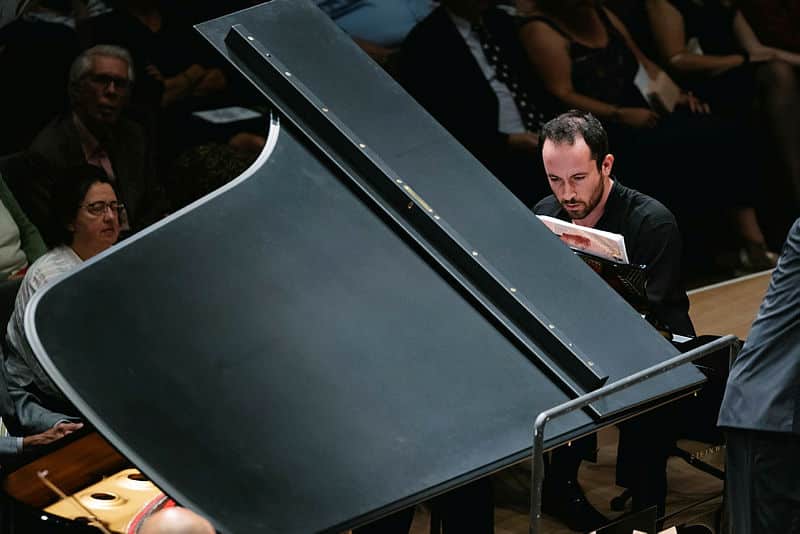Opera premiere is cancelled for lack of funds
mainLibby Larsen’s sci-fi opera A Wrinkle in Time has been pulled by Fort Worth Opera because it cannot raise the cash in time for next year’s fest.
More here.
Libby Larsen’s sci-fi opera A Wrinkle in Time has been pulled by Fort Worth Opera because it cannot raise the cash in time for next year’s fest.
More here.
Deborah Borda, acting CEO, confirmed today that principal…

You really couldn’t make it up. Well, they…

A Kennedy Center interview with LB dropped irresistibly…

We reported earlier that Franz Welser-Möst had withdrawn…

Session expired
Please log in again. The login page will open in a new tab. After logging in you can close it and return to this page.
A Wrinkle in Time was first performed by Opera Delaware and the Second performance was done by my company Opera Theatre of Northern Virginia. Libby Larsen was there. She spoke after the performance and the author of the book Madeleine L’engle was also there and she spoke as well.
So while it was a planned performance–and now a cancelled performance–it is incorrect to say it is a PREMIERE. It has already BEEN premiered.
John Edward Niles
Opera Delaware has an annual budget of 850K. The average budget of a major opera houses is 150 million – i.e. over 150 times higher. As far as I can see, the Opera Theater of Northern Virginia doesn’t even have a website.
This Fort Worth production was slated to cost 1.2 million, considerably more than the entire yearly budget of Opera Delaware.
I don’t mean it as any disrespect for your efforts, which are very noble, but I could well imagine that Ms. Larson might not consider these performances a genuine premiere of her work, especially in light of what her intentions for the staging might be, and quite possibly not in terms of the size of the orchestra. It seems to me unlikely, for example, that these two productions had all of the video and audio equipment she envisioned.
Of course my thoughts in this case might be intirely wrong, but American opera composers are so hard pressed for performances, they often let things be called premieres when they are actually more like workshop performances.
I and perhaps many others would like more info and your thoughts about this. I think a lot more thought needs to be given to what constitutes a genuine premiere. I think of the practice, for example, of Broadways shows first being performed numerous times in huge venues in cities like Chicago, but calling the Broadway performance that comes later the premiere. What is a premiere? Is it the first performance? Or is it the first time the work is done according to the intentions of the composer and librettist?
Listed on Libby’s own Web site:
Premiere March 1992 by Opera Delaware. (sniff, sniff…William Osborne)
http://libbylarsen.com/index.php?contentID=235&profileID=1230&startRange=
Probably a premiere for Fort Worth, right?
The newspaper article above calls it a world premiere. Did FWO advertise it as such, and was Larson agreed? Would it be fair for a composer to decide an earlier performance was inadequate and retract it as the premiere?
I would consider that attitude insulting to the many, many smaller opera companies who do the vast bulk of opera premieres in the US. If an opera was performed, if it’s music was heard, if a company used its resources, its time and its considerable effort to produce it, it has been premiered. Usually without those premieres, larger companies do not even look at the work.
A Broadway premiere is just that – a premiere on Broadway. Just as A Wrinkle in Time would have been a FWO premiere, or a Met Opera premiere, or Texas premiere, or NY premiere, an onward. It would not have been even remotely a world premiere.
Or is the insult the extreme poverty under which opera companies have to work in America? Germany, for just one example, has one fulltime opera house for every one million people. By that ratio, the USA would have 320 fulltime houses. As it is, we don’t have any. Our longest season is only 7 months, at the Met. And we only have 3 cities in the top 100 for opera performances per year (see the stats in another post below.)
See also this interesting map of Germany’s opera house landscape. Note how in the densely populated Ruhrgebiet of Germany, there are 11 fulltime opera houses within a 35 mile radius. :
http://www.miz.org/dokumente/musiktheater.pdf
If America’s Northeastern seaboard had the same sort of opera landscape, there would be full-time, year-round professional houses in Long Island, Newark, Jersey City, Trenton, Camden, Philadelphia, Wilmington, Baltimore, New Haven, Hartford, Springfield, Providence, and Boston.
In many respects, America’s opera companies are indeed living insults to any decent standard of how the arts should be supported. The low production standards sometimes even cause American composers to wonder if their works have been truly premiered, regardless of what they might list on their portfolios.
Madeleine L’Engle died in 2007, and had been incapacitated for several years beforehand, so the second production (by OTNV) at which she appeared had to have happened at least seven years ago, and probably quite a bit earlier. In can understand the importance of performances at larger opera houses with bigger budgets, but it seems to be stretching it to have a third staging of a work seven or more years after it first appeared, no matter how much more lavishly-done, labeled as the “premiere.”
Fort Worth ranks 295th in the world for opera performances per year. Not too surprising to see them further reducing their season.
Neighboring Dallas recently built a posh new opera house, of course named after a wealthy donor, but the city still ranks 257th the world for opera performances per year.
The USA only has 3 cities in the top 100 for opera performances per year. Two of them, Chicago and San Francisco, don’t even make the top 50.
The opera house at Kennedy Center was built over 40 years ago, but Washington D.C. still ranks 182nd in the world for opera performances per year (while having the world’s 11th largest metro GDP.)
Look at the rankings for a few other capital cities, all listed on the website of Operabase:
Vienna 1
Berlin 2
Paris 3
Moscow 4
Prague 6
London 7
Budapest 9
Stockholm 14
Sydney 16
Madrid 17
Even Athens in impoverished Greece comes in at 28th.
Then comes Washington at 182nd. Our so-called National Opera housed in Kennedy Center is in reality our national joke. These disgraceful numbers exist because of our dysfunctional system of funding the arts by donations from the wealthy. The USA is the only developed country in the world without a comprehensive system of public arts funding.
I still do not understand if these figures include smaller companies. How are they compiled?
The stats are compiled by Operabase. You can read about their work here.
http://www.operabase.com/index.cgi?lang=en
The stats are compiled from programs. Small companies are included. Wilmington is ranked 412th for opera performances per year. I’m not sure where the Opera Company of Northern Virginia is based. Maybe in Arlington, but that city does not appear in the Opera base listing.
Yes, I know Operabase. I don’t think the majority of small opera companies where many premieres are held are included. I don’t what the requirement is, but I can think of four world premieres in three states I’ve seen in the last two years and none of the companies are there. There is far more opera in the US than those focused on big or even medium houses would know, and it’s impressive work that reaches audiences not being reached otherwise.
There also are a number of companies that are members of Opera America but not represented in Operabase.
When the stats go all the way down to 768th in the world, we can be fairly sure a lot of small companies are being covered.
If there is a lack of inclusion, it tells me that these premieres are being done with small groups using pickup musicians and singers who do not have a change to build professional cohesiveness. They often work in rental facilities poorly suited to opera. They have no genuine scene shops, no costume shops, no storage facilities, and poor suited rehearsal spaces. They lack staff, and even what they do have can’t gain the kind of experience and expertise a full time house offers. Just about everything is fly-by-night which makes it hard to record their work on Operabase, much less have confidence in its quality.
Their efforts, idealism, and self-sacrifice are incredibly noble, and the results they get under these conditions are often surprisingly good, but these problems won’t be solved until we face them honestly and begin finding solutions.
This is FWO’s “Spiderman.” Millions required to replicate a teenager’s movie experience at the opera. Folly!
I was fortunate to have Libby Larson as a TA when I was a flute performance major at the UofM. It was evident even in that capacity that she was simply brilliant. I wish her the best of luck with having this fascinating opera brought to the public, after what can only be a temporary setback.
William Osborne, the average budget of a major opera house is not $150 million.
It might depend on how one defines major – hopefully not by American standards. In 2008, for example, the annual operating budget of the Vienna Staatsoper, one of the busiest in the world, was 100 million Euros (137 million dollars.) See:
http://en.wikipedia.org/wiki/Vienna_State_Opera
The Paris Opera’s annual budget is in the order of 200 million Euros – or 270 million dollars. See:
http://en.wikipedia.org/wiki/Paris_Opera
The annual budget of the Met averages around 320 million.
Even if you pushed the average for major houses like La Scala and ENO down to less than a third of the Met or half less than half the Paris Opera, it would still be 100 million. That would be over 100 times higher than Opera Delaware.
Even at the most conservative estimate of 80 million, the USA would only have 3 houses that approach that level. The so-called “Houston Grand Opera” had a budget of only $20 million in the 2010/11 season – less than 1/6th of the Vienna State Opera, less than 1/10th of the Paris Opera, and less than 1/15th of the Met.
It would be interesting to compare the budgets of the top 20 houses in Europe with the top 20 in the USA. It would be a disgrace. And as we see here, a truth even Americans in the arts are reluctant to face.
The Royal Opera House in London has a budget near 100 million Euros per year – or 137 million dollars. See:
http://www.theartsdesk.com/buzz/who-earns-%C2%A3630000-royal-opera-house
The San Francisco Opera has a 70 million dollar annual budget – but it only has a 5 month season. A full season like major European houses would thus run about 140 million. See:
http://www.sfgate.com/news/article/David-Gockley-seeks-to-overhaul-S-F-Opera-funding-2372782.php
(Interestingly, the San Francisco Opera’s endowment is only 136 million – about the size of the Vienna State Opera’s yearly budget.)
The Chicago Lyric’s estimated expenses for fiscal 2013 are $65.7 million – again for about a 5 month season. Double it, more or less, for what a major house with a full season would spend and it comes to 130 million. See:
https://www.google.com/search?q=santa+fe+opera+budget&oq=santa+fe+opera+budget&aqs=chrome..69i57.8529j0j4&sourceid=chrome&espv=210&es_sm=93&ie=UTF-8
In 2010 the budget of the Santa Fe Opera was 16.5 million for a six week season. See:
https://www.santafeopera.org/thecompany/news/pressreleases/detail.aspx?id=3752
If that budget were multiplied by 8 to get a 48 week season typical of a genuinely major house it would come to 132 million.